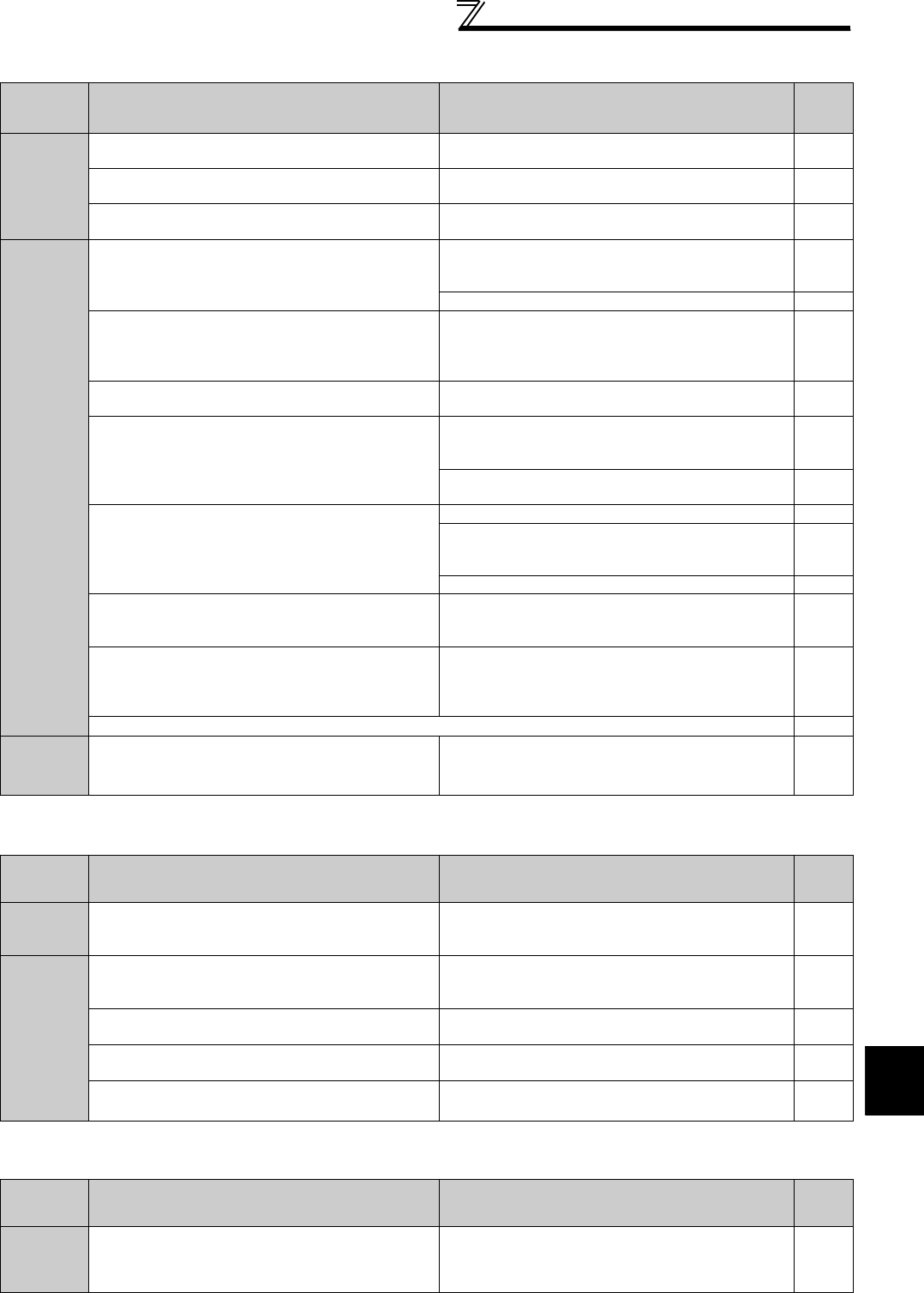
425
Check first when you have a trouble
5
PROTECTIVE FUNCTIONS
5.5.12 Speed does not accelerate
5.5.13 Unable to write parameter setting
5.5.14 Power lamp is not lit
Check
points
Possible Cause Countermeasures
Refer
to
page
Input
signal
Start command and frequency command are chattering.
Check if the start command and the frequency
command are correct.
—
The wiring length used for analog frequency command
is too long, and it is causing a voltage (current) drop.
Perform analog input bias/gain calibration.
294
Input signal lines are affected by external EMI.
Take countermeasures against EMI, such as using
shielded wires for input signal lines.
54
Parameter
Setting
Pr. 1, Pr. 2, Pr. 18, calibration parameter C2 to C7 settings
are improper.
Check the settings of Pr. 1 Maximum frequency and Pr. 2
Minimum frequency. If you want to run the motor at 120Hz
or higher, set Pr. 18 High speed maximum frequency.
157
Check the calibration parameter C2 to C7 settings. 294
The maximum voltage (current) input value is not set
during the external operation. (Pr.125, Pr.126, Pr.18)
Check the Pr.125 Terminal 2 frequency setting gain
frequency and Pr.126 Terminal 4 frequency setting gain
frequency settings. To operate at 120Hz or higher, set
Pr.18 High speed maximum frequency.
157,
294
Torque boost (
Pr. 0, Pr. 46, Pr. 112
) setting is improper under
V/F control, so the stall prevention function is activated.
Increase/decrease Pr. 0 Torque boost setting value by
0.5% increments so that stall prevention does not occur.
146
V/F pattern is improper when V/F control is performed.
(Pr. 3, Pr. 14, Pr. 19)
Set rated frequency of the motor to Pr. 3 Base frequency.
Use Pr. 19 Base frequency voltage to set the base
voltage (e.g. rated motor voltage).
159
Change Pr. 14 Load pattern selection according to the load
characteristic.
161
Stall prevention (torque limit) function is activated due to
a heavy load.
Reduce the load weight. —
Set Pr. 22 Stall prevention operation level (Torque limit level)
higher according to the load. (Setting Pr. 22 too large
may result in frequent overcurrent trip (E.OC).)
152
(100)
Check the capacities of the inverter and the motor. —
Auto tuning is not performed under Advanced magnetic
flux vector control, Real sensorless vector control, or
vector control.
Perform offline auto tuning. 189
The setting of pulse train input is improper.
Check the specification of the pulse generator (open
collector output or complementary output) and check the
adjustment of the pulse train and frequency (Pr. 385 and
Pr. 386).
378
During PID control, output frequency is automatically controlled to make measured value = set point.
361
Main
Circuit
Brake resistor is connected across terminals P/+ and
P1 or across P1 and PR by mistake. (22K or lower)
Remove the jumper across terminals PR and PX (7.5K
or lower) and connect an option brake resistor (FR-ABR)
across terminals P/+ and PR.
14
Check
points
Possible Cause Countermeasures
Refer
to
page
Input
signal
Operation is being performed (signal STF or STR is
ON).
Stop the operation.
When Pr. 77 = "0" (initial value), write is enabled only
during a stop.
307
Parameter
Setting
You are attempting to set the parameter in the External
operation mode.
Choose the PU operation mode.
Or, set Pr. 77 = "2" to enable parameter write regardless
of the operation mode.
307
Parameter is disabled by the Pr. 77 Parameter write
selection setting.
Check Pr. 77 Parameter write selection setting.
307
Key lock is activated by the Pr. 161 Frequency setting/key
lock operation selection setting.
Check Pr. 161 Frequency setting/key lock operation selection
setting.
393
Operation mode and a writing device do not
correspond.
Check Pr. 79, Pr. 338, Pr. 339, Pr. 550, Pr. 551, and select
an operation mode suitable for the purpose.
313,
322
Check
points
Possible Cause Countermeasures
Refer
to
page
Main
Circuit,
Control
Circuit
Wiring or installation is improper.
Check for the wiring and the installation.
Power lamp is lit when power is input to the control
circuit (R1/L11, S1/L21).
16


















